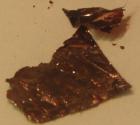
| |

| |
| Names | |
|---|---|
| IUPAC name
Gallium selenide
| |
| Other names
Gallium monoselenide
| |
| Identifiers | |
3D model (JSmol)
|
|
| ChemSpider | |
| ECHA InfoCard | 100.031.523 |
PubChem CID
|
|
| |
| |
| Properties | |
| GaSe | |
| Molar mass | 148.69 g/mol |
| Appearance | brown solid |
| Density | 5.03 g/cm3 |
| Melting point | 960 °C (1,760 °F; 1,230 K) |
| Band gap | 2.1 eV (indirect) |
Refractive index (nD)
|
2.6 |
| Structure | |
| hexagonal, hP8 | |
| P63/mmc, No. 194 | |
| Related compounds | |
Other anions
|
Gallium(II) oxide, Gallium(II) sulfide, Gallium(II) telluride |
Other cations
|
Zinc(II) selenide, Germanium monoselenide, Indium monoselenide |
Related compounds
|
Gallium(III) selenide |
Except where otherwise noted, data are given for materials in their standard state (at 25 °C [77 °F], 100 kPa).
| |
Gallium(II) selenide (GaSe) is a chemical compound. It has a hexagonal layer structure, similar to that of GaS.[1] It is a photoconductor,[2] a second harmonic generation crystal in nonlinear optics,[3] and has been used as a far-infrared conversion material[4] at 14–31 THz and above.[5]
- ^ Greenwood, Norman N.; Earnshaw, Alan (1997). Chemistry of the Elements (2nd ed.). Butterworth-Heinemann. ISBN 978-0-08-037941-8.
- ^ Richard H. Bube; Edward L. Lind (1959). "Photoconductivity of Gallium Selenide Crystals". Phys. Rev. 115 (5): 1159–1164. Bibcode:1959PhRv..115.1159B. doi:10.1103/PhysRev.115.1159.
- ^ J. M. Auerhammer; E. R. Eliel (1996). "Frequency doubling of mid-infrared radiation in gallium selenide". Opt. Lett. 21 (11): 773–775. Bibcode:1996OptL...21..773A. doi:10.1364/OL.21.000773. PMID 19876154.
- ^ N.B. Singh; D.R. Suhre; V. Balakrishna; M. Marable*; R. Meyer*; N. Fernelius; F.K. Hopkins; D. Zelmon (1998). "Far-infrared conversion materials: Gallium selenide for far-infrared conversion applications". Progress in Crystal Growth and Characterization of Materials. 37 (1): 47–102. doi:10.1016/S0960-8974(98)00013-8.
- ^ Kübler, C.; et al. (2005). Kobayashi, Takayoshi; Okada, Tadashi; Kobayashi, Tetsuro; et al. (eds.). Ultrabroadband detection of multi-THz field transients with GaSe electro-optic sensors (PDF). Springer Series in Chemical Physics. Vol. 79. doi:10.1007/b138761. ISBN 3-540-24110-8.